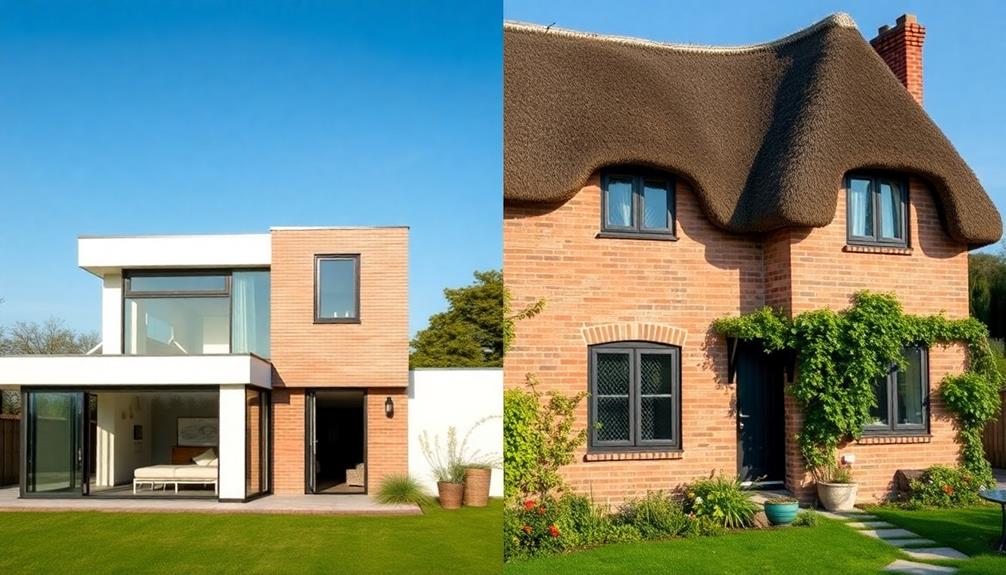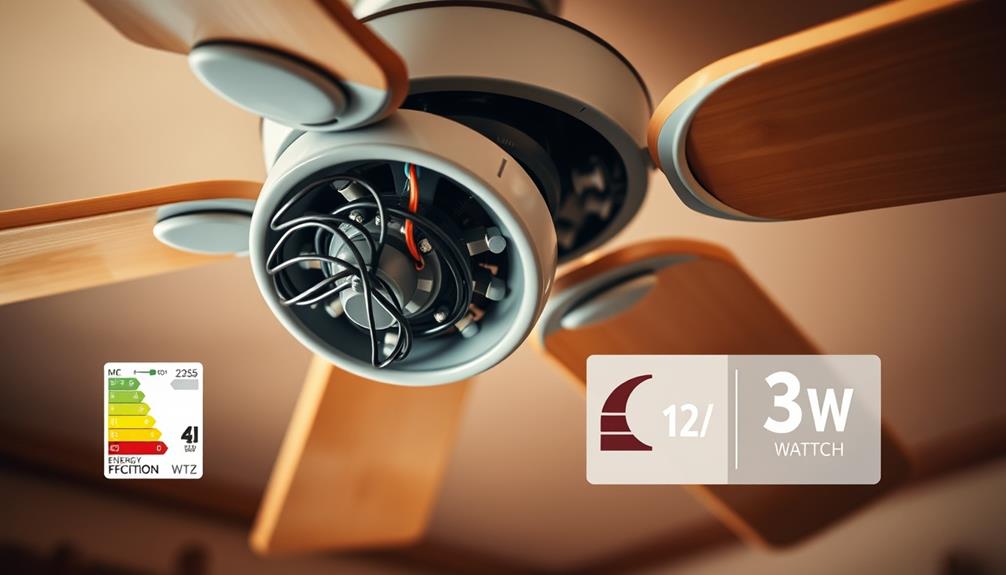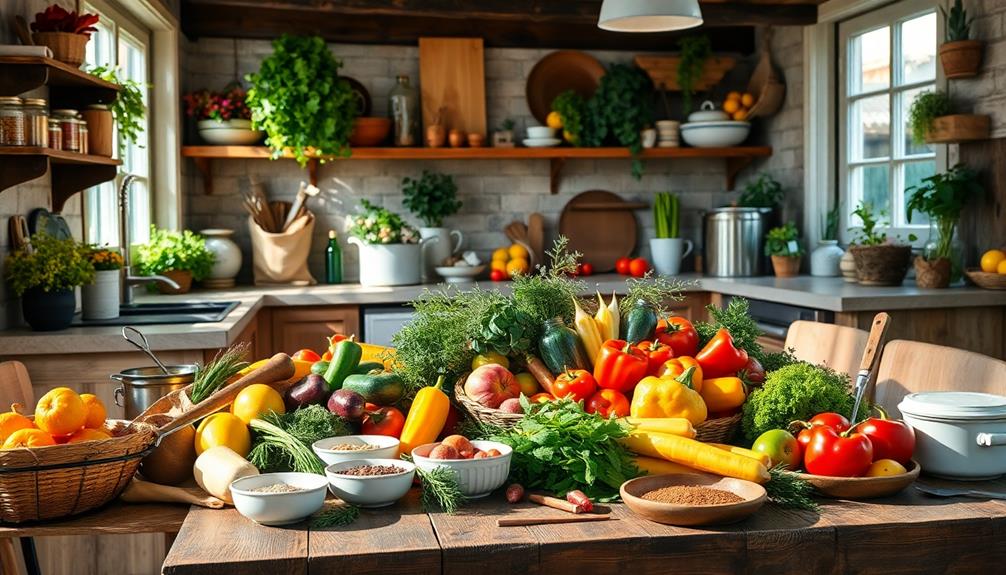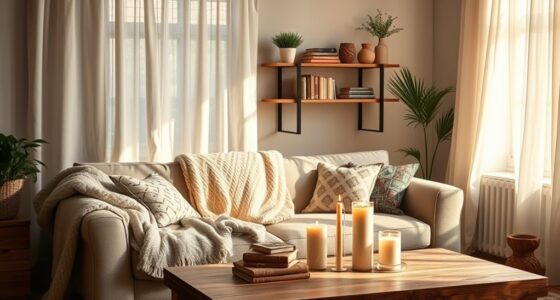When you're comparing modern and traditional homes, you'll notice distinct differences in style and materials. Modern homes prioritize minimalism with open spaces, flat roofs, and materials like steel and glass that emphasize efficiency and contemporary aesthetics. In contrast, traditional homes embrace rich histories with defined rooms, ornate details, and natural materials that create warmth. Color palettes also differ, as modern designs often use neutral tones, while traditional styles favor deep hues. Each approach reflects unique values and lifestyle preferences, making your choice a personal one. Stick around to discover the finer points of this architectural showdown.
Key Takeaways
- Modern homes emphasize minimalism with open spaces and sleek materials like steel and glass, promoting a contemporary aesthetic.
- Traditional homes showcase historical craftsmanship with ornate details and natural materials, creating warmth and a cozy atmosphere.
- Material selection in modern designs focuses on energy efficiency, while traditional choices prioritize character and lower environmental impact.
- Color palettes differ significantly; modern homes favor subdued tones, whereas traditional homes utilize deep hues to evoke warmth and nostalgia.
- Roof styles contrast, with modern homes often featuring flat roofs for a minimalist look, while traditional homes boast sloped roofs for visual appeal and durability.
Architectural Design Variances
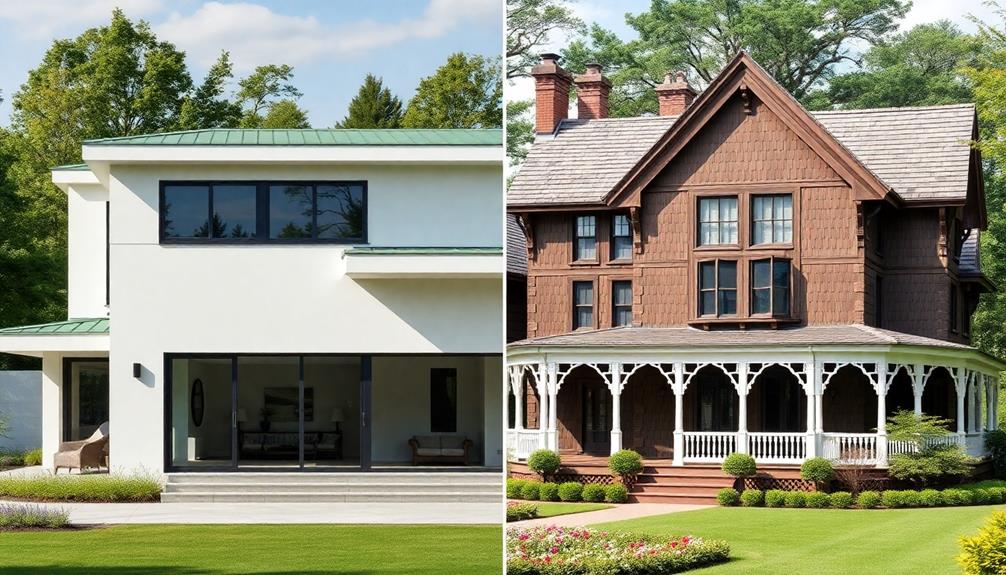
When you explore architectural design variances, you'll notice striking differences between modern and traditional homes.
Modern architecture embraces minimalism, focusing on clean lines and open-concept spaces that prioritize functionality. This approach often features large windows and an industrial aesthetic, creating a sense of spaciousness and light.
In contrast, traditional homes showcase historical elements with ornate details, symmetrical layouts, and rich craftsmanship. These structures often incorporate defined rooms, enhancing the cozy, intimate feel.
The evolution of these styles reflects modern innovation against the timeless appeal of tradition. You might find that modern designs cater to contemporary lifestyles, while traditional homes evoke nostalgia and a connection to the past, offering a distinct character that resonates with different preferences.
Material Selection Distinctions
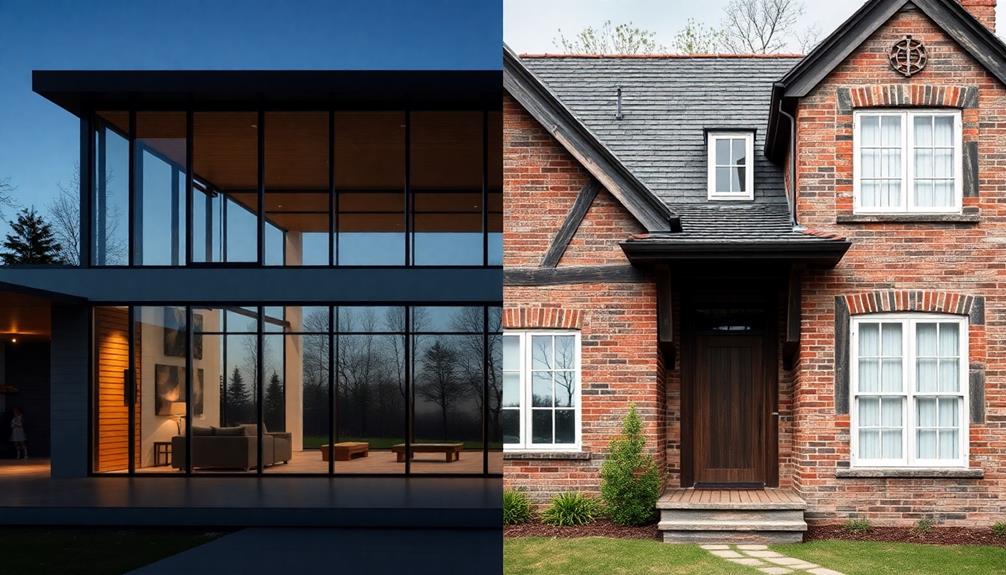
Material selection plays an essential role in defining the character and functionality of a home. In modern homes, you'll often see sleek steel and expansive glass, creating a contemporary feel and promoting open spaces.
These materials emphasize minimalism and efficiency, enhancing the overall aesthetic. Incorporating features like DIY fire pit ideas can further elevate outdoor spaces, blending modern design with functional elements.
On the other hand, traditional homes rely on natural materials like wood and brick, which convey warmth and timelessness. This choice not only reflects craftsmanship but also adds unique character and charm.
Additionally, the environmental footprint varies considerably between these styles; traditional materials tend to have a lower impact, while modern options may prioritize durability and longevity.
Ultimately, your choice in materials will considerably shape your home's identity and functionality.
Modern Materials Overview
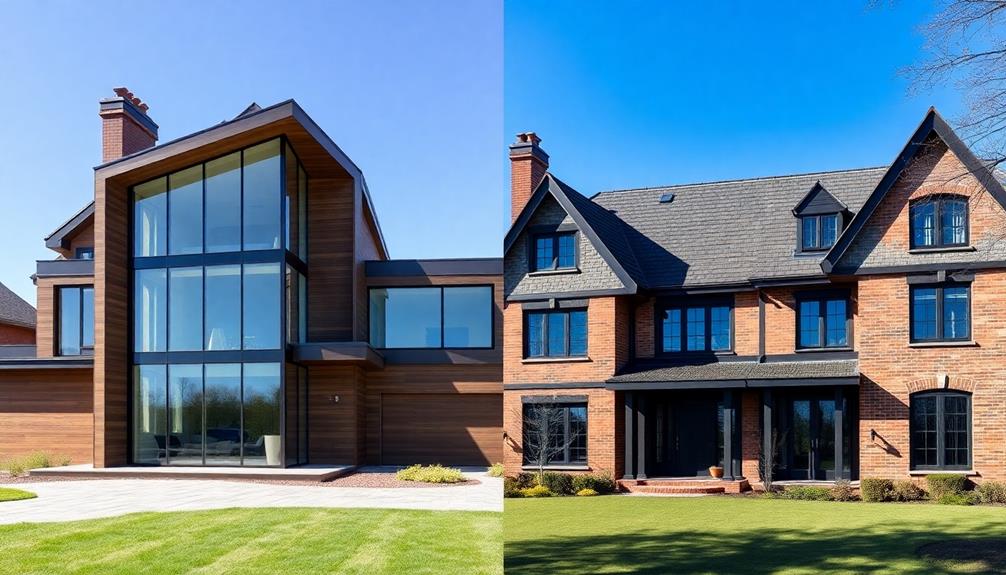
Choosing the right materials is key to achieving a modern aesthetic in your home. You'll find that cutting-edge materials like steel, glass, and concrete play pivotal roles in defining contemporary designs.
Steel's strength and sleekness create structural integrity, while expansive glass elements enhance transparency and connect your spaces with the outdoors. Concrete's durability adds a minimalist appeal, making it a preferred choice for many modern homes.
Additionally, opting for energy-efficient appliances can further enhance your modern home's functionality and sustainability, as they help reduce overall energy consumption energy-efficient appliances.
Additionally, industrial finishes provide a contemporary atmosphere that complements your overall design.
As sustainability becomes increasingly important, incorporating eco-friendly materials not only supports the environment but also elevates your home's style.
Traditional vs. Contemporary Choices
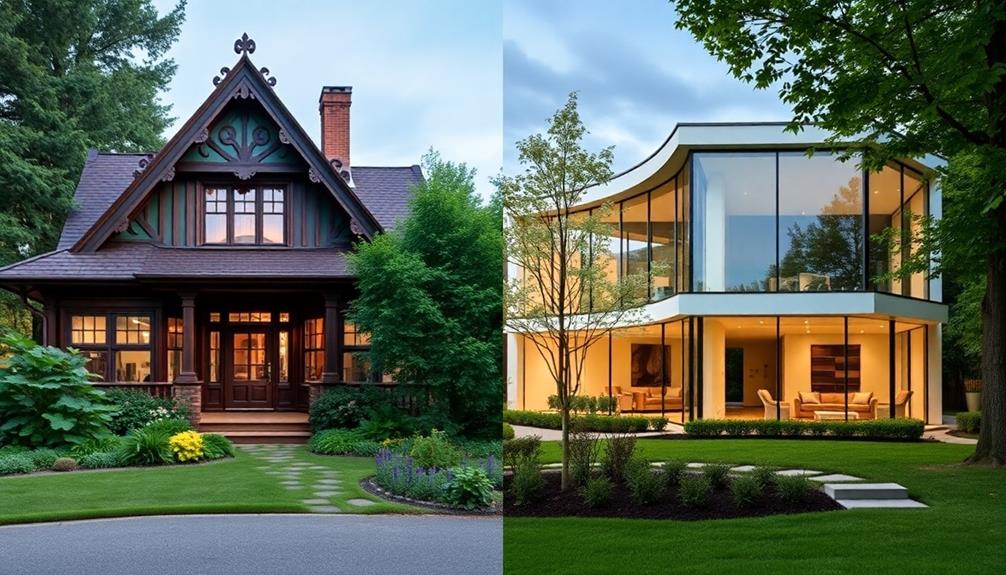
In the domain of home design, the distinction between traditional and contemporary choices is enthrallingly clear. Traditional homes embrace classic craftsmanship and rich histories, while contemporary designs focus on innovation and functionality. You'll notice that color schemes also differ markedly, with traditional homes showcasing deep, rich hues versus the subdued, neutral palettes of modern spaces. Each style caters to distinct lifestyle preferences and values.
| Feature | Traditional Choices | Contemporary Choices |
|---|---|---|
| Design Focus | Classic craftsmanship | Innovative functionality |
| Color Palette | Deep, rich hues | Subdued, neutral tones |
| Layout | Symmetrical and ornate | Open-concept and minimalist |
| Materials | Wood, brick, and stone | Steel, glass, and concrete |
| Aesthetic Appeal | Timeless and historical | Sleek and modern |
Impact of Material Selection
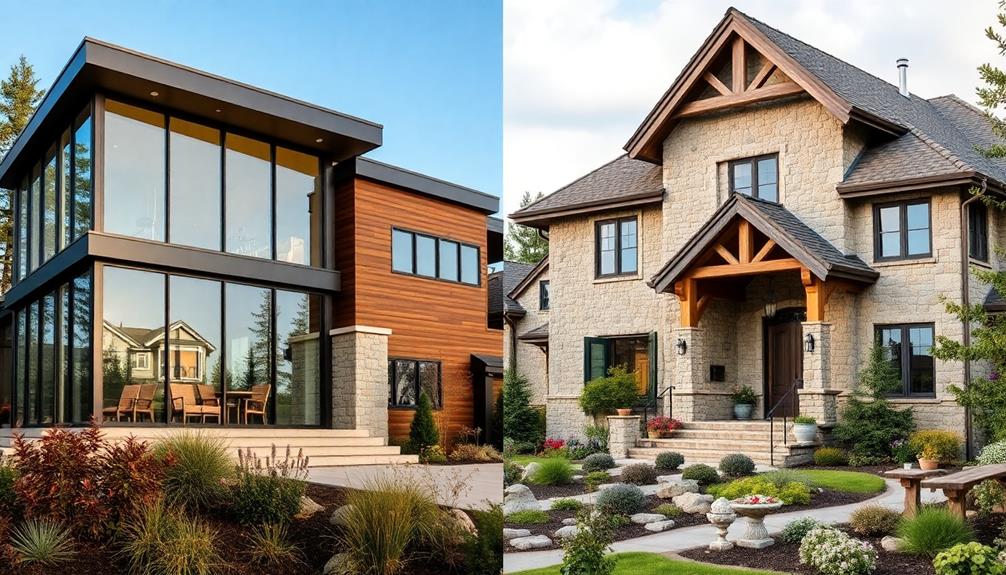
The choice of materials in home design greatly influences both aesthetics and functionality. When you opt for modern materials like steel and glass, you're embracing a sleek, contemporary look that often enhances energy efficiency.
For instance, using high-efficiency options in heating, such as wood pellet stoves, can contribute to sustainable living practices. These materials can withstand the elements better, offering durability and longevity.
On the other hand, if you lean towards traditional materials such as brick and wood, you're likely prioritizing warmth and character, while also minimizing environmental impact. Each choice reflects your values and lifestyle needs.
Sustainability is becoming a key consideration, pushing you to explore eco-friendly options in modern designs. Ultimately, your material selection will shape not only the visual appeal of your home but also its performance and environmental footprint.
Color Palette Variation
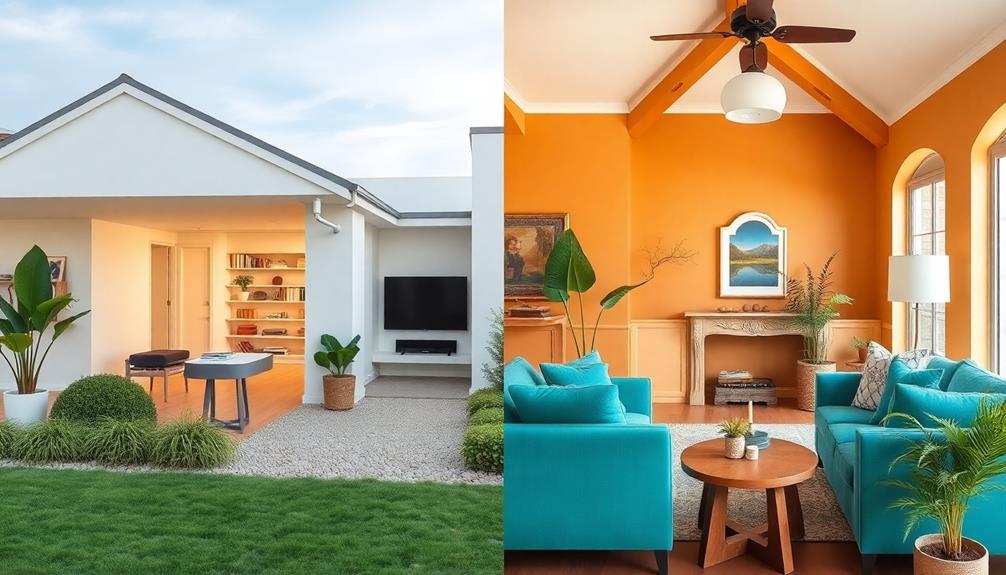
How do color palettes influence the overall feel of your home? In traditional homes, you'll often find deep, rich hues that evoke warmth and history. These bold colors can create a cozy atmosphere, highlighting architectural details and crafting a sense of heritage.
On the other hand, modern homes typically embrace subdued, neutral palettes that promote a sleek and airy vibe. This minimalist approach not only enhances spaciousness but also allows for accent colors to pop, adding visual interest without overwhelming the senses.
Your choice of color can greatly impact mood and perception, whether you lean towards the classic charm of traditional styles or the clean lines of contemporary designs.
Ultimately, it's about creating the environment you desire.
Roof Styles Contrast
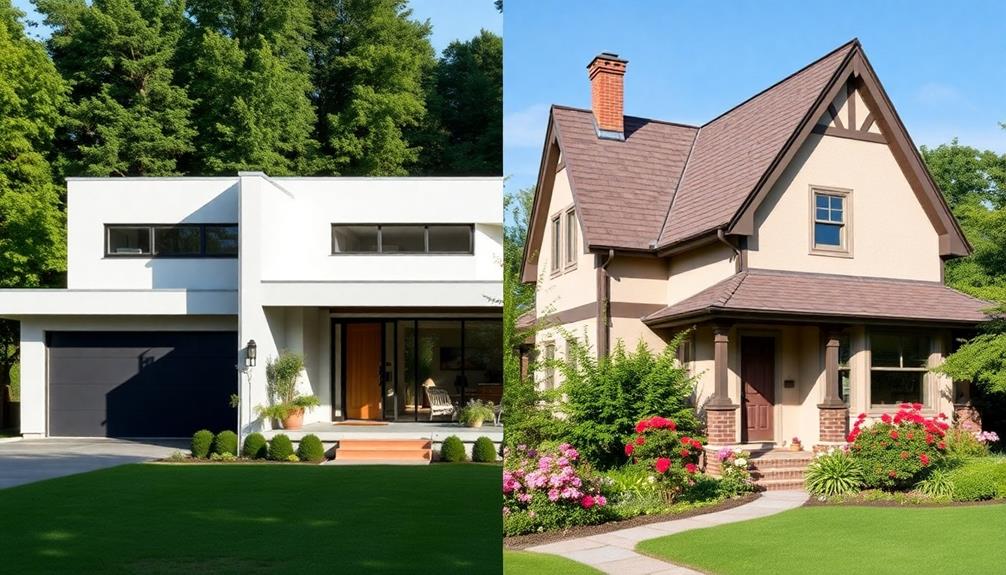
Roof styles play an essential role in defining a home's overall aesthetic and functionality.
If you lean towards modern design, you'll appreciate the sleek look of flat roofs, which create a minimalist silhouette. These roofs often allow for rooftop gardens, providing valuable outdoor space in urban settings.
On the other hand, traditional homes typically sport sloped roofs, enhancing their visual charm and historical appeal. These roofs also improve water drainage, ensuring durability and longevity.
When you choose between modern and traditional designs, consider how the roof style reflects your values and lifestyle. Each option offers unique advantages, so think about what best fits your aesthetic preferences and practical needs.
Frequently Asked Questions
What Are the Maintenance Differences Between Modern and Traditional Homes?
When it comes to maintenance, modern homes often require less upkeep due to durable materials, while traditional homes might need more frequent care because of their intricate designs and natural materials. You'll want to contemplate both.
How Do Energy Efficiency Ratings Compare for Both Home Styles?
Wondering how energy efficiency ratings stack up? Modern homes often boast higher ratings due to advanced materials and designs, while traditional homes can be surprisingly efficient with natural materials, depending on their construction and insulation choices.
What Is the Average Lifespan of Materials Used in Each Style?
When you consider the average lifespan of materials, modern homes often use durable options like steel and concrete, lasting decades. Traditional homes, with wood and brick, typically require more maintenance but can also last a long time.
How Do Resale Values Differ Between Modern and Traditional Homes?
You won't believe the difference in resale values! Modern homes often attract higher prices due to their sleek designs and energy efficiency, while traditional homes hold their charm, appealing to buyers seeking character and history.
What Design Trends Are Emerging in Modern and Traditional Homes?
You'll notice emerging trends like sustainable materials and open layouts in modern homes, while traditional designs are incorporating smart technology and eco-friendly practices. Both styles are adapting to contemporary needs while preserving their unique charm.
Conclusion
In the end, whether you lean towards the sleek lines of modern design or the intricate charm of traditional homes, remember that your space reflects who you are. It's funny how a simple choice—like a bold color or a cozy material—can transform a house into a home. Just like you, each style has its quirks and comforts. So, embrace what resonates with you, and let your personality shine through your architectural choices!
